City Council approves new rezoning and development plans including digital sign restrictions
July 02, 2025 | Tulsa, Tulsa County, Oklahoma
This article was created by AI summarizing key points discussed. AI makes mistakes, so for full details and context, please refer to the video of the full meeting. Please report any errors so we can fix them. Report an error »

The Tulsa Metropolitan Area Planning Commission convened on July 2, 2025, to discuss several key developments impacting the city. The meeting, led by Susan Miller, highlighted recent approvals from the city council that are poised to shape the urban landscape of Tulsa.
One significant topic was the approval of zoning changes at two contrasting locations: the northeast corner of the city at 56th Street North and 145th East Avenue, and another site at 120th Avenue in Apache. These decisions reflect ongoing efforts to manage land use effectively in response to community needs.
Additionally, the commission reviewed a rezoning request for a digital sign at 41st and Harvard. The city council mandated specific provisions to ensure the sign would adhere to aesthetic standards, emphasizing the importance of maintaining visual consistency in urban signage. This decision underscores the balance between commercial interests and community aesthetics.
The meeting also addressed amendments related to roof signs and farmers markets, both of which were approved by the city council. These changes are expected to enhance local commerce and community engagement, particularly in supporting farmers markets as vital community hubs.
Another noteworthy discussion involved a subdivision project at 11th and 130th Avenue. Originally approved for RS-3 zoning, the project was recently rezoned to RS-5 to increase the number of lots available, yielding approximately 17 additional lots. This adjustment aims to accommodate the growing housing demand in the area, reflecting the city's commitment to expanding residential options.
In conclusion, the meeting underscored the commission's proactive approach to urban planning and development in Tulsa. As the city continues to evolve, these decisions will play a crucial role in shaping the community's future, addressing both housing needs and aesthetic considerations. The commission's next steps will likely involve monitoring the implementation of these changes and their impact on the local environment.
One significant topic was the approval of zoning changes at two contrasting locations: the northeast corner of the city at 56th Street North and 145th East Avenue, and another site at 120th Avenue in Apache. These decisions reflect ongoing efforts to manage land use effectively in response to community needs.
Additionally, the commission reviewed a rezoning request for a digital sign at 41st and Harvard. The city council mandated specific provisions to ensure the sign would adhere to aesthetic standards, emphasizing the importance of maintaining visual consistency in urban signage. This decision underscores the balance between commercial interests and community aesthetics.
The meeting also addressed amendments related to roof signs and farmers markets, both of which were approved by the city council. These changes are expected to enhance local commerce and community engagement, particularly in supporting farmers markets as vital community hubs.
Another noteworthy discussion involved a subdivision project at 11th and 130th Avenue. Originally approved for RS-3 zoning, the project was recently rezoned to RS-5 to increase the number of lots available, yielding approximately 17 additional lots. This adjustment aims to accommodate the growing housing demand in the area, reflecting the city's commitment to expanding residential options.
In conclusion, the meeting underscored the commission's proactive approach to urban planning and development in Tulsa. As the city continues to evolve, these decisions will play a crucial role in shaping the community's future, addressing both housing needs and aesthetic considerations. The commission's next steps will likely involve monitoring the implementation of these changes and their impact on the local environment.
View full meeting
This article is based on a recent meeting—watch the full video and explore the complete transcript for deeper insights into the discussion.
View full meeting
